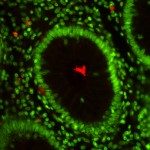Link to Pubmed [PMID] – 15088068
EMBO Rep. 2004 May;5(5):477-83
Type III secretion (TTS) systems are used by many Gram-negative pathogens to inject virulence proteins into the cells of their hosts. Several of these virulence effectors require TTS chaperones that maintain them in a secretion-competent state. Whereas most chaperones bind only one effector, Spa15 from the human pathogen Shigella flexneri and homologous chaperones bind several seemingly unrelated effectors, and were proposed to form a special subgroup. Its 1.8 A crystal structure confirms this specific classification, showing that Spa15 has the same fold as other TTS effector chaperones, but forms a different dimer. The presence of hydrophobic sites on the Spa15 surface suggests that the different Spa15 effectors all possess similar structural elements that can bind these sites. Furthermore, the Spa15 structure reveals larger structural differences between class I chaperones than previously anticipated, which does not support the hypothesis that chaperone-effector complexes are structurally conserved and function as three-dimensional secretion signals.

